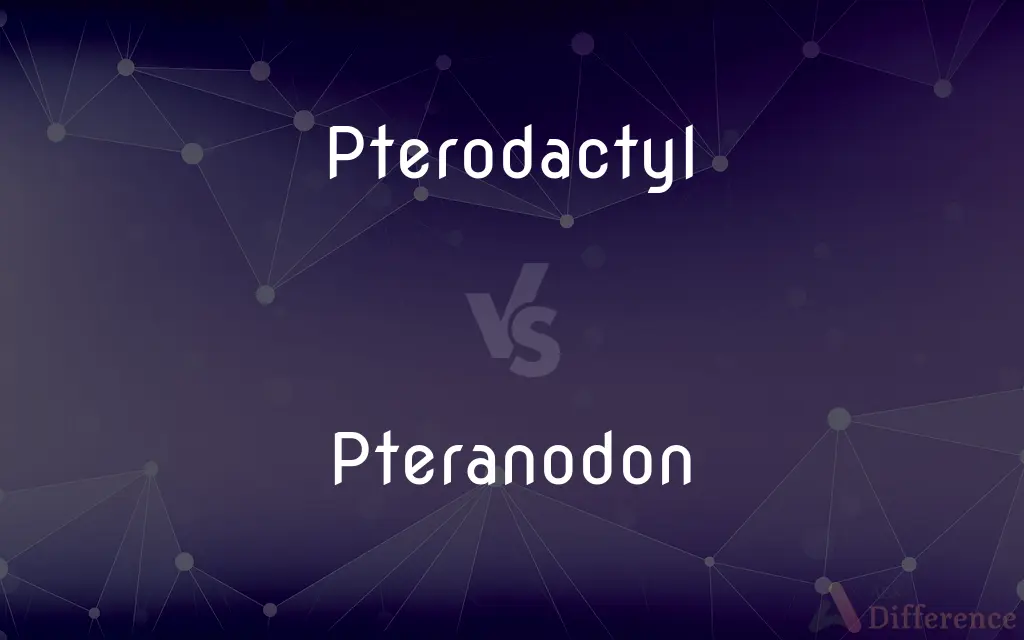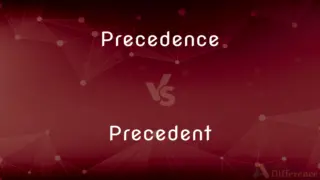Pterodactyl vs. Pteranodon — What's the Difference?
By Tayyaba Rehman & Fiza Rafique — Updated on September 14, 2023
Pterodactyl is a general term often used to describe flying reptiles from the Jurassic period, while Pteranodon is a specific genus of pterosaur from the Late Cretaceous period. They differ in size, crest structure, and geological timeframe.

Difference Between Pterodactyl and Pteranodon
Table of Contents
ADVERTISEMENT
Key Differences
Pterodactyl is a colloquial term often applied to various types of pterosaurs, flying reptiles that lived during the time of the dinosaurs. Pteranodon, on the other hand, is a specific genus of pterosaur that existed during the Late Cretaceous period. The term "Pterodactyl" is often used inaccurately to describe all pterosaurs, while "Pteranodon" refers to a particular species with well-defined characteristics.
In terms of physical features, Pterodactyls generally lacked the large crests that are a hallmark of Pteranodons. The Pteranodon is notable for its large, backward-pointing crest, which is believed to have been used for stabilization during flight. Pterodactyls, being a broad category, exhibited a wider range of physical traits.
Pterodactyls lived during various periods, including the Jurassic and possibly earlier, whereas Pteranodons existed specifically during the Late Cretaceous period. This difference in geological timeframes means that they would not have coexisted. Additionally, Pteranodons were typically larger than what people generally think of as Pterodactyls.
Linguistically, the term "Pterodactyl" is derived from the Greek words for "wing" and "finger," describing their wing structure. Pteranodon comes from Greek words meaning "wing" and "toothless," highlighting its lack of teeth. Both terms are nouns in the English language, and they often appear in scientific and popular discussions about prehistoric life.
Comparison Chart
Genus or General Term
General term for various pterosaurs
Specific genus of pterosaur
ADVERTISEMENT
Crest
Generally lacks large crests
Notable for its large crest
Geological Timeframe
Various, including Jurassic
Late Cretaceous
Size
Generally smaller
Typically larger
Etymology
From Greek "wing" and "finger"
From Greek "wing" and "toothless"
Compare with Definitions
Pterodactyl
Flying reptiles from prehistoric times.
Pterodactyls have always fascinated paleontologists.
Pteranodon
A specific genus of pterosaur from the Late Cretaceous period.
Pteranodons are often featured in documentaries about the Late Cretaceous.
Pterodactyl
Generally lacks large crests.
This pterodactyl model doesn't have a crest, unlike the Pteranodon model.
Pteranodon
Lived specifically during the Late Cretaceous period.
Pteranodon fossils are markers of the Late Cretaceous era.
Pterodactyl
A colloquial term for various pterosaurs.
The movie inaccurately showed a pterodactyl living alongside dinosaurs.
Pteranodon
Generally larger than Pterodactyls.
This Pteranodon replica dwarfs the Pterodactyl model.
Pterodactyl
Lived during multiple geological periods.
Pterodactyl fossils are primarily found from the Jurassic era.
Pteranodon
Known for its large, backward-pointing crest.
The Pteranodon's crest may have helped stabilize its flight.
Pterodactyl
Derived from Greek words meaning "wing" and "finger."
The word pterodactyl aptly describes the creature's wing structure.
Pteranodon
Derived from Greek words meaning "wing" and "toothless."
The Pteranodon was aptly named for its lack of teeth.
Pterodactyl
A pterosaur of the late Jurassic period, with a long slender head and neck and a very short tail.
Pteranodon
Pteranodon (; from Greek πτερόν (pteron, "wing") and ἀνόδων (anodon, "toothless")) is a genus of pterosaur that included some of the largest known flying reptiles, with wingspans over 7 meters (23 feet). They lived during the late Cretaceous geological period of North America in present-day Kansas, Alabama, Nebraska, Wyoming, and South Dakota.
Pterodactyl
Any of various pterosaurs of the group Pterodactyloidea of the Jurassic and Cretaceous Periods, having a short tail or no tail, and including the pteranodons.
Pteranodon
A large tailless pterosaur of the Cretaceous period, with a long toothless beak, a long bony crest, and a wingspan of up to 7 m.
Pterodactyl
(paleontology) A pterosaur in the genus Pterodactylus.
Pteranodon
Any of several large pterosaurs of the genus Pteranodon of the Cretaceous Period, having a long crested head, a scooplike beak, no teeth, and a wingspan of over 8 meters (26 feet).
Pterodactyl
(informal) Any pterosaur.
Pteranodon
A member of Pteranodon, a genus of large pterosaurs, the males of which had a bony crest on the back of the head.
Pterodactyl
An extinct flying reptile; one of the Pterosauria. See Illustration in Appendix.
Pteranodon
A genus of American Cretaceous pterodactyls destitute of teeth. Several species are known, some of which had an expanse of wings of twenty feet or more.
Pterodactyl
Extinct flying reptile
Common Curiosities
Are Pterodactyls and Pteranodons the same size?
Pteranodons are generally larger than what people think of as Pterodactyls.
When did Pterodactyls and Pteranodons live?
Pterodactyls lived during multiple periods, while Pteranodons lived in the Late Cretaceous.
What is a Pteranodon?
Pteranodon is a specific genus of pterosaur from the Late Cretaceous.
What does Pterodactyl mean?
The term comes from Greek words meaning "wing" and "finger."
Do Pterodactyls and Pteranodons have crests?
Pterodactyls generally lack large crests, whereas Pteranodons have notable ones.
Where are Pterodactyl fossils found?
They are primarily found from the Jurassic era.
What does Pteranodon mean?
It comes from Greek words meaning "wing" and "toothless."
Where are Pteranodon fossils found?
They are generally found from the Late Cretaceous period.
Are Pterodactyls and Pteranodons depicted accurately in movies?
Often not; movies tend to mix characteristics of different pterosaurs.
What is a Pterodactyl?
Pterodactyl is a general term often used for various pterosaurs.
Do Pterodactyls have teeth?
Some do, depending on the specific type.
Are Pterodactyls and Pteranodons dinosaurs?
No, both are pterosaurs, not dinosaurs.
Do Pteranodons have teeth?
No, they are toothless, as their name suggests.
Did Pterodactyls and Pteranodons coexist?
No, they lived during different geological periods.
Can Pterodactyl and Pteranodon be used interchangeably?
No, Pterodactyl is a general term, while Pteranodon refers to a specific genus.
Share Your Discovery

Previous Comparison
Will vs. Well
Next Comparison
Precedence vs. PrecedentAuthor Spotlight
Written by
Tayyaba RehmanTayyaba Rehman is a distinguished writer, currently serving as a primary contributor to askdifference.com. As a researcher in semantics and etymology, Tayyaba's passion for the complexity of languages and their distinctions has found a perfect home on the platform. Tayyaba delves into the intricacies of language, distinguishing between commonly confused words and phrases, thereby providing clarity for readers worldwide.
Co-written by
Fiza RafiqueFiza Rafique is a skilled content writer at AskDifference.com, where she meticulously refines and enhances written pieces. Drawing from her vast editorial expertise, Fiza ensures clarity, accuracy, and precision in every article. Passionate about language, she continually seeks to elevate the quality of content for readers worldwide.
















































